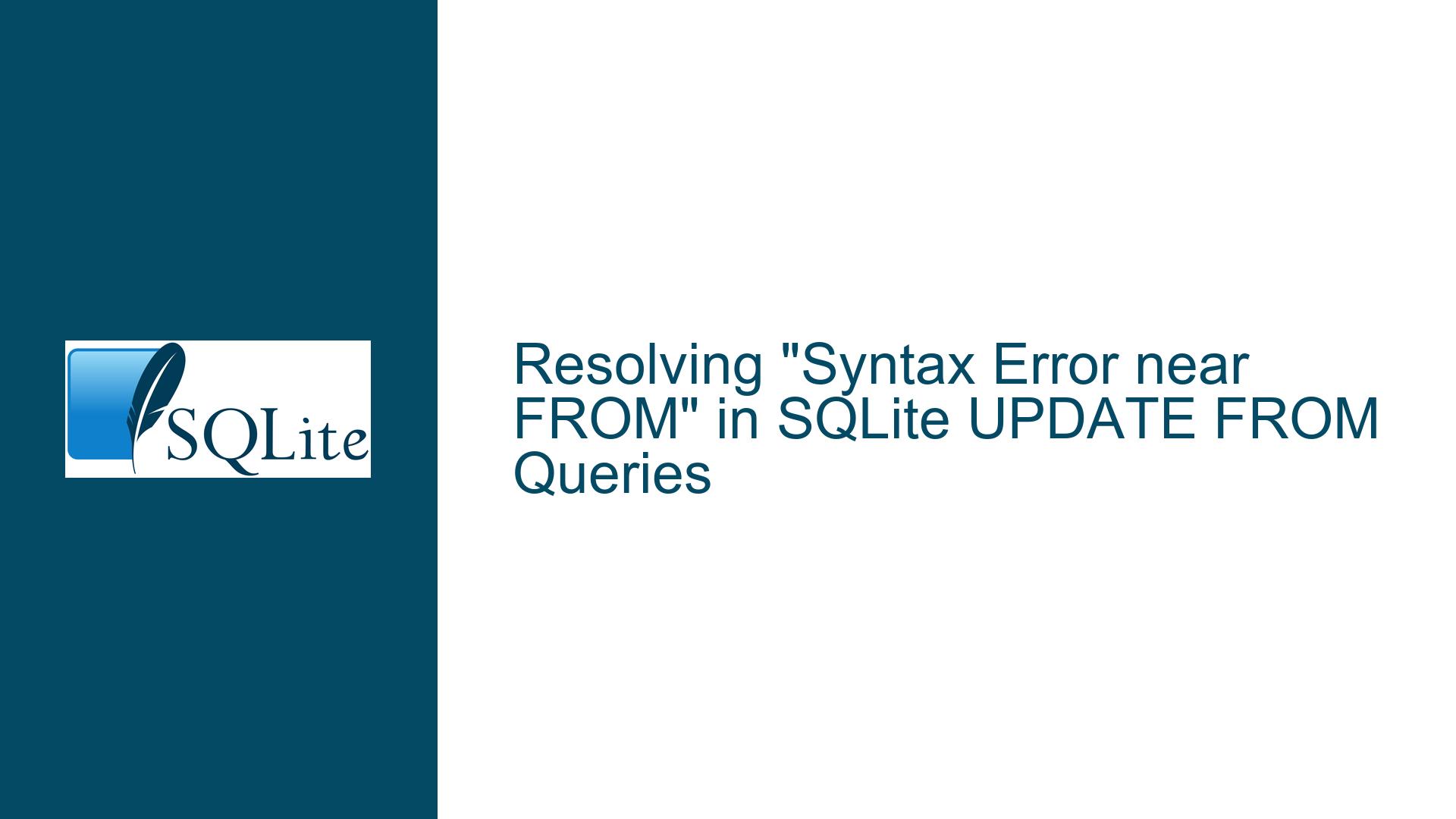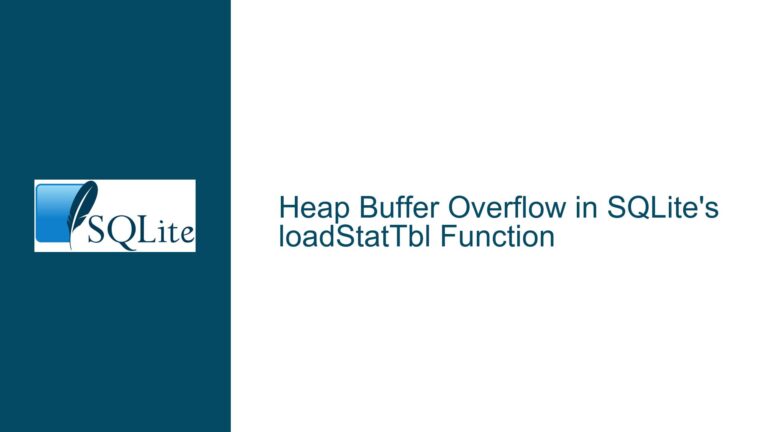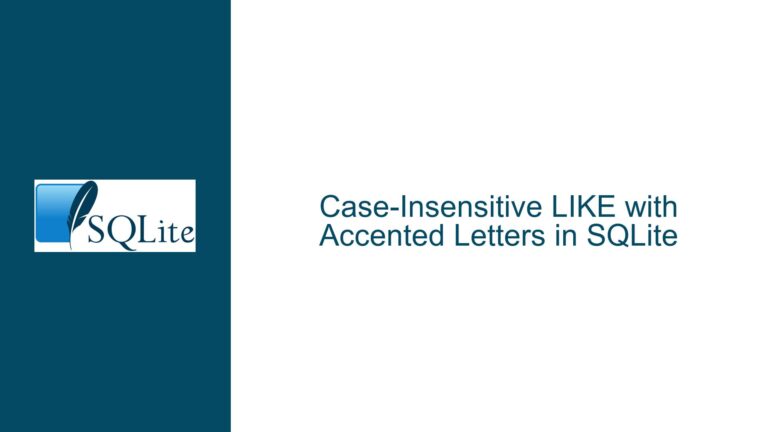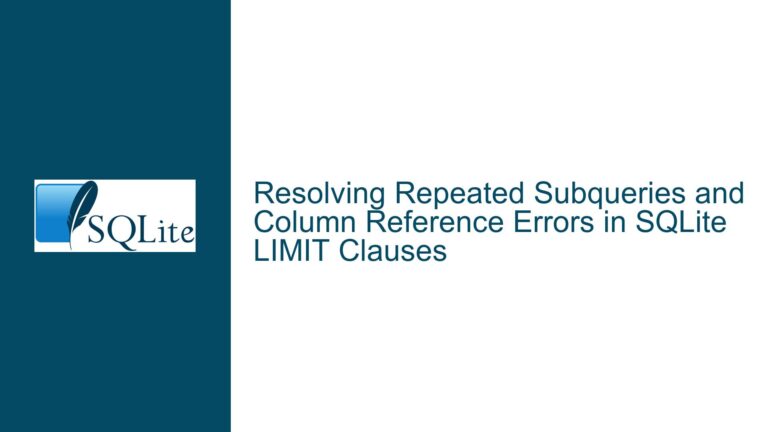Resolving “Syntax Error near FROM” in SQLite UPDATE FROM Queries
Issue Overview: Syntax Error When Using UPDATE FROM in Older SQLite Versions
The core issue arises when attempting to execute an UPDATE FROM query in SQLite, resulting in the error message Error: near "FROM": syntax error. This error occurs because the UPDATE FROM syntax is not recognized by the SQLite engine due to version incompatibility. The UPDATE FROM clause allows joining the target table with other tables or subqueries during an update operation, which is essential for batch updates based on aggregated data from related tables.
In the provided scenario, the user attempted to decrement the quantity column in the inventory table by the sum of quantity values from the sales table, grouped by itemId. The query structure follows the official SQLite documentation but fails due to environmental constraints. The failure manifests as a syntax error at the FROM keyword, indicating that the parser does not recognize the clause. This problem is compounded by secondary issues related to data type handling and schema design, which surface after resolving the primary syntax error.
Possible Causes: Version Compatibility, String Literal Formatting, and NULL Arithmetic
1. Outdated SQLite Version Lacking UPDATE FROM Support
SQLite introduced the UPDATE FROM syntax in version 3.33.0 (released August 2020). Versions prior to this do not support this syntax, causing the parser to reject the query. The user confirmed using SQLite 3.32.2 (released July 2021), which predates the feature. This version mismatch is the primary cause of the syntax error. The UPDATE FROM extension enables correlated updates by allowing the inclusion of additional tables or subqueries in the FROM clause, similar to PostgreSQL or MySQL syntax. Older versions require workarounds like subqueries in the SET clause or INNER JOIN within the UPDATE statement.
2. Incorrect String Literal Delimiters Leading to Ambiguity
While not the direct cause of the syntax error in this case, using double quotes ("item1") for string literals violates SQL standards and can lead to unexpected behavior in certain contexts. SQLite traditionally uses single quotes ('item1') for string literals and double quotes for identifier quoting (e.g., column or table names with spaces). Although SQLite 3.29.0+ tolerates double-quoted string literals in relaxed mode, this practice is discouraged for portability and clarity. In strict mode or with specific configurations, double-quoted literals may trigger "no such column" errors if interpreted as identifiers.
3. NULL Values in Arithmetic Operations Causing Silent Failures
The inventory table’s quantity column was populated without explicit values, defaulting to NULL. When performing arithmetic operations like quantity - daily.amt, subtracting a number from NULL yields NULL. This results in all quantity values becoming NULL after the update, which is likely unintended. The schema should enforce non-NULL constraints with default values (e.g., DEFAULT 0) to ensure valid arithmetic operations.
Troubleshooting Steps, Solutions & Fixes
Step 1: Verify SQLite Version and Upgrade If Necessary
Action:
Check the current SQLite version using the command:
SELECT sqlite_version();
Outcome:
If the version is below 3.33.0, the UPDATE FROM syntax is unsupported. For example, version 3.32.2 will fail, whereas 3.42.0 (as tested) works.
Solution:
Upgrade SQLite to version 3.33.0 or newer.
- Windows/macOS: Download precompiled binaries from SQLite Download Page.
- Linux: Use package managers:
sudo apt update && sudo apt install sqlite3
Workaround for Older Versions:
Rewrite the UPDATE query using a correlated subquery or INNER JOIN:
UPDATE inventory
SET quantity = quantity - (
SELECT SUM(quantity)
FROM sales
WHERE sales.itemId = inventory.itemId
);
This approach avoids the FROM clause by embedding the aggregation within the SET clause.
Step 2: Correct String Literal Formatting and Schema Design
Action:
Replace double-quoted string literals with single quotes:
INSERT INTO inventory (itemID) VALUES ('item1');
-- Instead of VALUES ("item1");
Schema Adjustment:
Modify the inventory table to enforce non-NULL quantities with a default value:
CREATE TABLE inventory (
itemId VARCHAR(32) PRIMARY KEY,
quantity INTEGER NOT NULL DEFAULT 0
);
This prevents NULL in quantity and initializes new entries to 0.
Data Correction:
Update existing NULL values to 0 before running the UPDATE FROM query:
UPDATE inventory SET quantity = 0 WHERE quantity IS NULL;
Step 3: Execute the Corrected UPDATE FROM Query
Valid Query Structure:
UPDATE inventory
SET quantity = quantity - daily.amt
FROM (
SELECT itemId, SUM(quantity) AS amt
FROM sales
GROUP BY itemId
) AS daily
WHERE inventory.itemId = daily.itemId;
Post-Update Validation:
Query the inventory table to confirm expected results:
SELECT * FROM inventory;
Expected output shows decremented quantities (e.g., item4 reduced by 40).
Common Pitfalls:
- Grouping Column Mismatch: Ensure the
GROUP BYcolumn aligns with the join key. UsingGROUP BY 2(column index) is fragile; preferGROUP BY itemId. - Case Sensitivity: SQLite treats identifiers as case-insensitive by default but preserves case. Verify
itemIdcasing consistency across tables. - Transaction Handling: Wrap the update in a transaction for atomicity in production environments:
BEGIN TRANSACTION; -- UPDATE statement COMMIT;
Additional Considerations for Robust SQLite Queries
Indexing for Performance:
Add indexes on join columns to optimize UPDATE FROM performance:
CREATE INDEX idx_inventory_itemId ON inventory(itemId);
CREATE INDEX idx_sales_itemId ON sales(itemId);
Testing with EXPLAIN QUERY PLAN:
Analyze the query execution plan to identify inefficiencies:
EXPLAIN QUERY PLAN
UPDATE inventory ...;
Handling Concurrent Writes:
Use BEGIN EXCLUSIVE TRANSACTION in high-concurrency scenarios to prevent conflicts during updates.
Cross-Platform Compatibility:
Ensure queries adhere to SQL standards if migrating between database systems. For example, UPDATE FROM syntax differs in PostgreSQL and MySQL.
By systematically addressing version compatibility, schema design, and query syntax, users can resolve the syntax error and achieve reliable, maintainable UPDATE FROM operations in SQLite.






